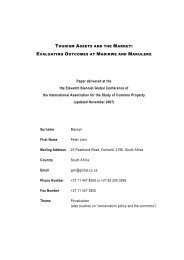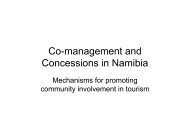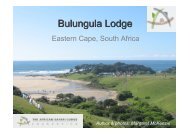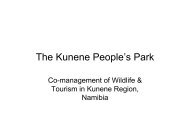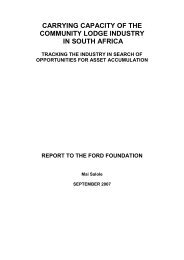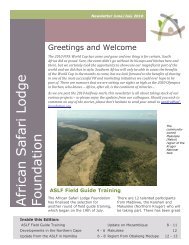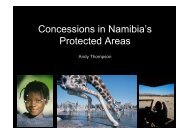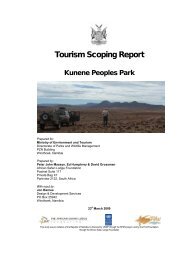Tourism Development Plan Khomani San Community - The African ...
Tourism Development Plan Khomani San Community - The African ...
Tourism Development Plan Khomani San Community - The African ...
Create successful ePaper yourself
Turn your PDF publications into a flip-book with our unique Google optimized e-Paper software.
TOURISM DEVELOPMENT PLAN - ‡KHOMANI SAN COMMUNITY<br />
<strong>The</strong> Mier people also inhabited the area that now constitutes part of the Park, and they too have a<br />
history of dispossession. Like the <strong>San</strong>, the Mier were also allowed to continue living in certain<br />
areas within the Park, but lost their rights to hunt and manage stock on the land and were<br />
eventually forcibly removed to state land reserved for them under the settlement schemes of the<br />
1930s.<br />
<strong>The</strong> proclamation of the Park was followed by gazetting of Botswana’s Gemsbok National Park<br />
(2,840,000ha) in 1938. <strong>The</strong> two parks were amalgamated as the Kgalagadi Transfrontier Park<br />
(KTP) in 1999 following the signing of a bilateral agreement between the South <strong>African</strong> and<br />
Botswanan governments.<br />
In 1995 the ‡<strong>Khomani</strong> <strong>San</strong> community lodged a claim for the restitution of 400,000ha of land in<br />
the Kalahari Gemsbok Park. In December 1998, the Mier community, represented by the Mier<br />
Transitional Local Council, lodged its own land claim for land both inside and outside the Park.<br />
After many years of negotiation and verification, the claims were finally settled on 21 st March<br />
1999, with the official transfer of title to six Kalahari farms (approximately 34,728ha) to the<br />
‡<strong>Khomani</strong> <strong>San</strong> Common Property Association (CPA), a form of collective trust allowed by the<br />
Communal Property Associations Act (No. 28 of 1996) for use by communities that have<br />
benefited from land restitution under the Restitution of Land Rights Act (No. 22 of 1994).<br />
Supplemental to this, in 2007 it was agreed that a further two farms (Sonderwater and Rolletjies -<br />
approximately 6,020ha) be transferred to the ‡<strong>Khomani</strong> <strong>San</strong> CPA; however up to now the<br />
allocation of title has not yet been completed (Chennells, pers. comm., 2010).<br />
In addition, after further negotiations, on 29 th May 2002 the conditional allocation of some<br />
57,903ha of land within the Park – to be managed as a Contractual National Park (!Ae!Hai<br />
Kalahari Heritage Park) – was committed to the ownership of the ‡<strong>Khomani</strong> <strong>San</strong> and Mier<br />
communities through what is known as the !Ae!Hai Kalahari Heritage Park Agreement<br />
(Chennells, pers. comm., 2010). In this Agreement the ‡<strong>Khomani</strong> <strong>San</strong> community were also<br />
granted preferential tourism rights over 80,000ha south of the Auob River inside the Park, and<br />
473,830ha of land between the Auob and Nossob Rivers as a symbolic and cultural zone.<br />
In the years after the land claim was settled, little development occurred on this land, with growing<br />
social decay and disintegration, lack of post-restitution support from the South <strong>African</strong> authorities,<br />
divisions within the now disparate community, and no significant improvement in the welfare of<br />
most community members being the order of the day. Until recently, most elders from the<br />
community had yet to set foot on their land in the Park, let alone enjoy the rights conferred upon<br />
them.<br />
<strong>The</strong>re are many factors that contribute to and exacerbate the situation within the ‡<strong>Khomani</strong> <strong>San</strong><br />
<strong>Community</strong> and these include (but are not limited to):<br />
• After nearly a century of being spread out in the diaspora, families and clans had developed in totally<br />
different directions. Some had retained most of the old ways, others had totally immersed themselves in<br />
modern life, or had eked out lives as an underclass in dismal squatter environments. Many had survived<br />
lives of unspeakable hardship and misery. <strong>The</strong> land claim brought these disparate <strong>San</strong>, linked by ancient<br />
blood ties, into one reconstituted community, overnight. <strong>The</strong> tensions and differences arising from<br />
countless perceptions, mistrust, lack of knowledge of each other in the community, were underestimated,<br />
and need to be addressed in order to further build up the community.<br />
• Racial discrimination remains rife in this area and this perpetuates the status quo and the sense of<br />
disempowerment that the <strong>San</strong> community experience.<br />
PAGE 14



